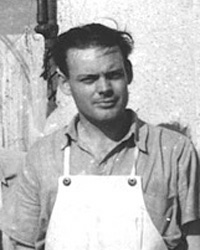
Walter Hammond Righter (1905 - 1982)An Illustrated Biography by his daughter, Frances Jean Righter Tucker © 2005
Chapter 3. From Dennymites to DronesLast Updated : July 25, 2005
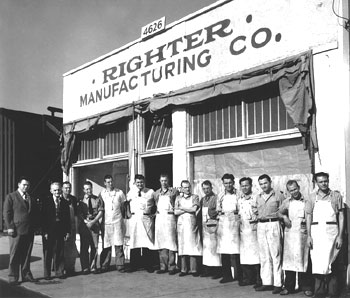
The Righter Manufacturing Co., 1937 L-R : Walter Righter, Albert 'Al' Holter, Donald Fulcher, Martin 'Hub' Herbrick, Herbert Waymire, Harry Telford, Dick Waymire, Peter E Pauley, Earl P. Daggett, John 'Jack' Lovick, Al De Lisle, Fred Hardy, Roy Patterson, Kenneth Case Photo: Righter Family Archives - Click Image to Enlarge Download a 1500 pixel image
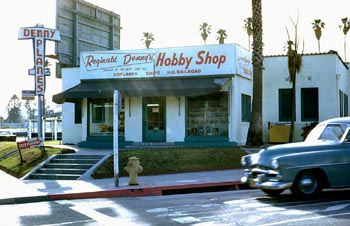 Reginald Denny's Hobby Shop, Hollywood Boulevard, 1961 Photo : Pete Soule - Click Image to Enlarge
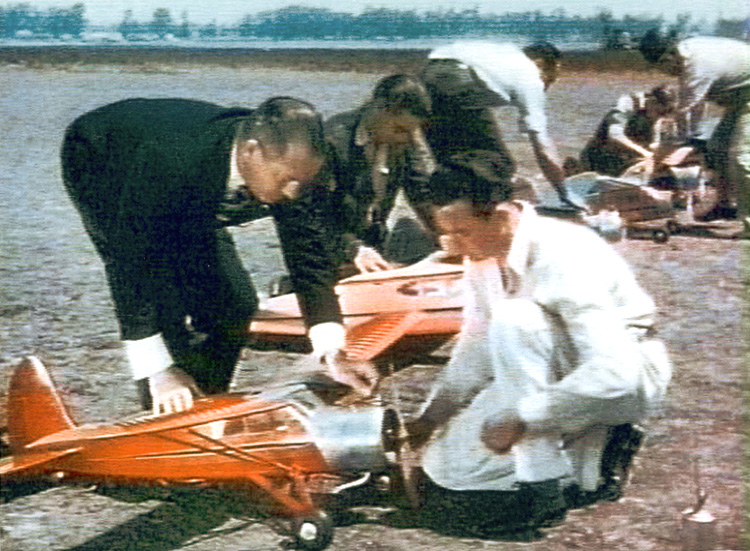 Reginald Denny, Fred hardy and far right, Walt Righter Photo : Jim Dunkin - Click Image to Enlarge
Sometimes, however, a plane would head off in one direction and land several miles away. On a few rare occasions it would be caught by a strong wind and the disgruntled unhappy owner would see his plane fade away in the distance, never to be retrieved no matter how far he chased it. Under these circumstances it was inevitable that some model builders did a lot of thinking about radio control. It is hard to know exactly who came up with the idea first, but the English were working on radio-controlled airplanes that were non-man carrying. They sent up a pilot with the plane and after he got it under control and all set he would bail out. The plane or now pilotless 'drone' would then be shot at and would eventually crash whether it was ever hit or not. One plane, (a DeHavilland DH82 Tiger Moth) converted by the British and called the "Queen Bee", flew out of radio range on its maiden voyage and after wandering about over the countryside for some time, finally crashed. There were also quite a number of young Americans working with radio control but the experiments only proved that the idea might have merit, but that the approach as yet was not practical.
It was in the early part of 1937 when amateur wireless operator and model aircraft builder Kenneth Case put his ideas into action and built a radio control system for his model and actually flew it with some success. Ken then took his model and radio control system and showed it to Reg Denny to see if he would be interested in it! Reg WAS definitely interested. In fact he became very enthusiastic and started to do a lot of talking about it. He even suggested that it could be used by the military for target practice.
It was reported that... "Walter Righter, a 1928 Cal Tech graduate and engine designer, submitted the winning engine. Mr. Righter became an important man in Reginald Denny's life, between 1937 and 1945. He designed and built most [in fact all of them, Ed.] of the thousands of engines for the Radioplane target drones. Walter Righter being the Daedalus ('skillful, architect, ingenious') of the fledgling drone industry. Righter, Case and Denny pooled their talents to develop many of the innovative systems used on the RP-3 and subsequent targets." It wasn't long before Lt. Col C. M. Thiele, Commanding officer of the Coast Artillery at Fort McArthur in San Pedro, CA. heard about it an got in touch with Reg. He invited Reg to come to San Pedro and demonstrate it. The invitation was accepted and Reg, a couple of others and Ken Case took his model plane with its radio to San Pedro. They demonstrated on the ground how everything worked and then cranked up the engine and started it off for a flight. Unfortunately, before the model was able to gain any altitude, it crashed into a grandstand along side of the parade grounds. In spite of the fact that the model plane had not made a flight of sufficient duration to allow the radio control to be demonstrated properly, Col. Thiele was quite well impressed. He suggested that another slightly larger model be built and when ready, he would organize a field trip to Dale Dry Lake near Twentynine Palms, where there would be plenty of room for a real test. His plan was enthusiastically accepted.
It was common at that time to build model airplanes up to 9 feet in span and sometimes larger. The first Radioplane (the RP-1) was effectively a 6 foot span Dennyplane scaled up to 9 feet [Ed.]They called the Righter Manufacturing Company and asked Dad to furnish a suitable engine. Since there was no such engine available on the market, it was necessary to design and build one with an output of around 2.5 horse power.
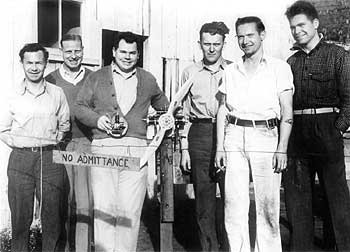 Walt's Dennymite model aero engine and the 'RP-1 Twin' Photo: Righter Family Archives - Click Image to Enlarge Download a 1500 pixel image
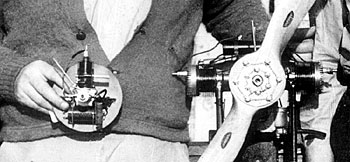 Walt's Dennymite model aero engine and the 'RP-1 Twin' Photo: Righter Family Archives - Click Image to Enlarge
Paul Whittier, who had become affiliated with Denny Industries, came over to Righter Manufacturing Company to check on Dad's progress and asked him if he thought the model was ready to fly. Dad said, "No, I don't believe that the landing gear is capable of withstanding a landing." Paul's reaction was, "Lets find out." So he took hold of the propeller and lifted the front of the plane about a foot off the ground and then dropped it. The landing gear completely collapsed and the fuselage hit the floor. Paul said, "You're right! you just now got yourself an order to design and build us a landing gear that will do the job." After some redesigning the front end of the plane, Dad and his men re-installed the engine. That was about Feb. 1, 1938. With that problem solved, they were now ready to demonstrate for Col. Thiele and he was so informed. The plan was to do the test flying at Dale Dry Lake near Twentynine Palms, about fifty miles NE of Palm Springs, CA, on Monday Feb. 21, 1938.
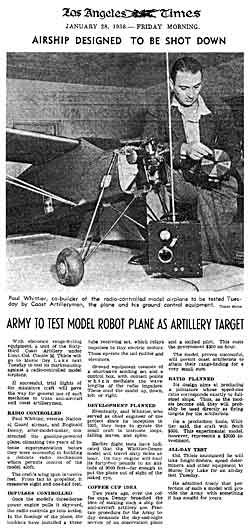 Airship Designed to be Shot Down Los Angeles Times Jan, 28, 1938 - Click Image to Enlarge Download a 750 pixel image
In the 1930s, Twentynine Palms consisted of a dozen or so small houses, one or two stores, and as far as one could see no palm trees. They asked directions to the dry lake then headed north for about three miles where they found the dry flat bed of a lake not much over a mile in diameter. It was an ideal place for their proposed flight.
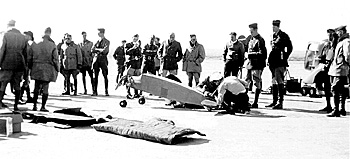 RP-1. Army Demo. Dale Dry Lake, Feb. 21,1938 Photo : Righter Family Archives - Click Image to Enlarge Download a 1500 pixel or 3000 pixel image [1.1Mb]
The engine was started and brought up to full throttle. The flight was launched by a quick short run by one of the fellows holding the tail and the model was in the air and climbing. It climbed to approximately two hundred feet above the take-off point and made a few turns under radio control. Then the radio control appeared to malfunction and the model soon hit the lake bed. Too much damage was done to even consider another flight.
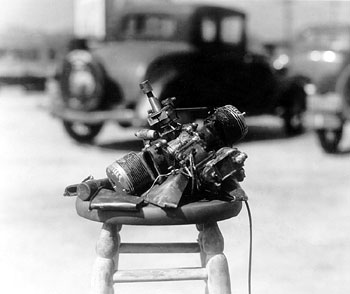 'RP-1 Twin' Photo: Righter Family Archives - Click Image to Enlarge
Both the radio transmitter and receiver were battery operated. Flight control was through a four-point stepping switch in the drone, which connected to motors and then to the rudder and elevators. To operate a control, the pilot (on the ground) pressed the control button connected to the transmitter, which in turn moved the stepping switch in the drone, one point (for example) to the right rudder. As long as the switch was held down the right rudder continued to be held. Release the button and the rudder returned to neutral.While they were waiting, wondering and probably worrying about what the military would do, if anything, Dad started working with Ken Case on a better design for the radio control this time with a 'joystick' replacing the telephone dial unit but still quite complicated because you had to remember the last moves you made in order to figure out the right direction for the next move. You couldn't just flip the joystick to the right and expect the drone to turn to the right, etc.
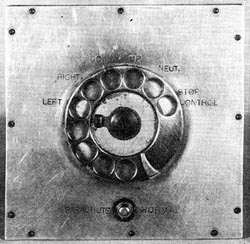 Telphone Dial Controller Model Airplane News, Sep., 1940 - Click Image to Enlarge
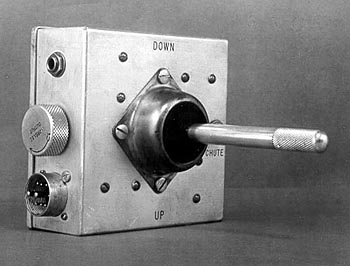 'Joystick' Controller Photo : Righter Family Archives - Click on Image to Enlarge
As Denny was the 'Star' of the team and great at 'PR', he has, until recently, received most of the credit for the Radioplane drones. At the time this suited Dad just fine, it didn't bother him; he just loved working on whatever his newest project was. A study of the 'Radioplane' such as this however, must tell the full story and as such, clearly report the tremendous input made by my father to this most amazing part of aviation history.
|
© Copyright 1999-2005 CTIE - All Rights Reserved - Caution |
